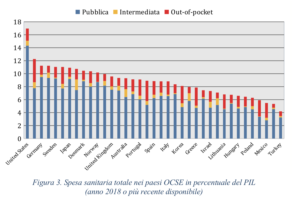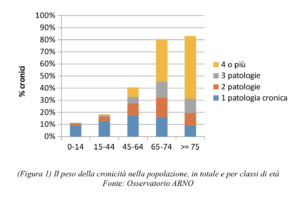Here is the digital disaster of Italian healthcare. Word of doctors and nurses

What emerged about digital health in some hearings of the Senate Health Committee
The picture of the state of health of the National Health Service that emerges from the informal hearings on the strengthening and redevelopment of territorial medicine in the post-Covid era held in the Health Commission of the Senate is bleak.
A misinterpreted corporatization
"Those who in recent decades have participated in the decision-making processes in health care have distorted the concept of corporatization, not cultivating its positive meaning, appropriateness, and exasperating its negative one, profit – reads the document that the Scientific Association of Digital Health ( Assd) presented to the Senate -. The result was that healthcare professionals had to face the emergency in a few, ill-equipped, within confused organizational models and on the basis of often contradictory indications ”.
Health cuts
A wrong corporateization is not the only problem of Italian health. “All governments – as Nino Cartabellotta , President of GIMBE writes and as reported by ASSD – have" plundered "health expenditure to face any financial emergency , certain that the NHS can always and in any case provide good results in terms of health. In order not to frustrate any action to relaunch public funding, it is therefore essential to first "heal" the vulnerability described above to avoid inexorable periodic downward revisions ". With the Covid19 epidemic, the National Health System received more additional resources in just one year than in the previous five. “The arrival, all at once, of an “ avalanche ”of resources risks creating the conditions for a subsequent boomerang effect – as stated in the White Paper of the ASSD -; the main reasons for concern are two: the first is that we cannot “remove” that post-COVID-19 Italy will be burdened by a stratospheric debt; the second is that, unfortunately, this is the country of “tape cuts”, followed however by a serious lack of maintenance. We need to pay the utmost attention, because, unfortunately, the experience of recent years gives us back a country where a large (too) part of the investments has not yielded returns, in fact hesitating in wasting public resources ”.

Chronic diseases account for 80% of health care costs
The WHO estimates that 80% of health care costs are absorbed by chronic diseases , those health problems that require continuous treatment over a period of time from years to decades. These conditions require a huge commitment of human, managerial and economic resources, in terms of both direct costs (hospitalization, drugs, medical assistance, etc.) and indirect costs (premature mortality, long-term disability, reduced quality of life, etc.) ), necessary for their control. Chronic diseases, as stated in the White Paper of the ASSD , they are progressively increasing and are often present simultaneously in the same individual. This translates into a new model of the patient who, especially in old age, is no longer an individual suffering from a single and well-defined acute pathology, but a chronic patient, suffering from several simultaneously incident pathologies.

The reform of primary care: the ASSD proposal
The proposal for the reform of primary care advanced by ASSD is divided into three points:
- the reorganization of primary care with the establishment of professional organizational and functional divisions of the District made up of General Practitioners and other operators in the district;
- the strengthening of health or community houses;
- the implementation of telemedicine, and in a broader sense of digital health, as an indispensable tool for realizing the medicine of the initiative.
Digital health: bringing health to the citizen
The primary purpose of digital healthcare, ASSD doctors say, is to bring healthcare to the citizen according to his or her needs. A result that today would be easier to achieve thanks to the development of information technology, digitalization, artificial intelligence, the irruption of new technologies and new treatments increasingly directed towards the personalization of treatments and the greater availability of economic resources.
Digital healthcare is not just telemedicine
Digital health, according to the doctors of the ASSD, is not synonymous with telemedicine. Among the healthcare professions protagonists of digital innovation are “ home radiology , molecular medicine and precision medicine, the creation of POCT Point Of Care Testing for analytical tests performed near or at the patient's point of care”. In this context, Covid "highlighted how essential it is to have the patient's clinical information shared between the healthcare staff who takes care of the patient, so here is the confirmation of the importance of having an FSE updated with the patient's clinical data", yes law in the report. Another legacy of the Covid experience is the dematerialization of the medical prescription . "To limit travel and reduce the spread of Coronavirus, it is now possible to obtain from your general practitioner the" Electronic Prescription Number "(NRE) – it reads -, with which to collect the drugs paid for by the NHS directly at the pharmacy, without a paper prescription ".
Reducing the digital divide
The White Paper “Italian Health after the Coronavirus emergency. The proposal of the Scientific Association of Digital Health ASSD ”underlines that our country is still far behind in the development of those networks necessary for digital health to take shape. The White Paper mentions the Colao report , presented to the Conte government during the pandemic, with a possible plan to restart the country. One of the chapters is dedicated to telecommunications infrastructures: "Systematic intervention is necessary to reduce the digital divide and make the country totally and universally connected, thus allowing the wide diffusion between companies and individuals of innovative technologies (eg. and Telemedicine, e-learning education, e-commerce purchases, contactless payments, etc.) – reads the report -. The ubiquitous development of the fiber optic network is the top priority , since it generates economic activity in the immediate future and stimulates future growth ”. Ultra-broadband connectivity in Italy is much more limited than in other countries, with great differences between the various geographical areas in terms of penetration and quality.
Formation and delay in the rooting of digital systems
Another issue on which the doctors of the ASSD focus is the professional training of digital skills. “ Specialized digital skills for IT personnel, basic digital skills for healthcare and administrative operators, eleadership skills for strategic health departments, basic digital training also for citizens, patients and caregivers – they write -. Yet training and continuous updating are still insufficient both in our universities and in the health authorities where health professionals work ”. The process of entrenching digital systems in care pathways is also slow “due to the lack of a sufficient critical mass of economic investments and the lack of a profound redesign of organizational processes . Without forgetting that, as reported by all the stakeholders, it is urgent to update the IT equipment of the hospitals, the local clinics and the doctors and operators of the NHS for hardware, software and networks ”.
This is a machine translation from Italian language of a post published on Start Magazine at the URL https://www.startmag.it/sanita/ecco-il-disastro-digitale-della-sanita-italiana-parola-di-medici-e-infermieri/ on Mon, 26 Apr 2021 04:14:01 +0000.
